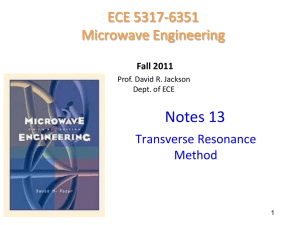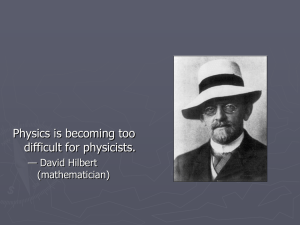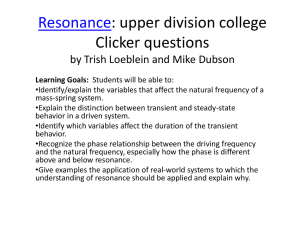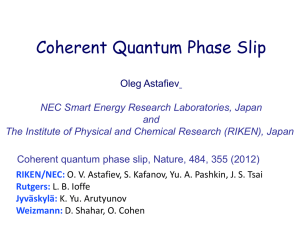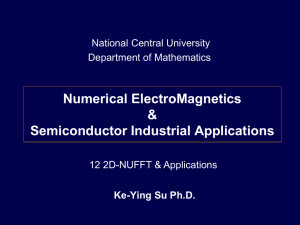pptx
advertisement
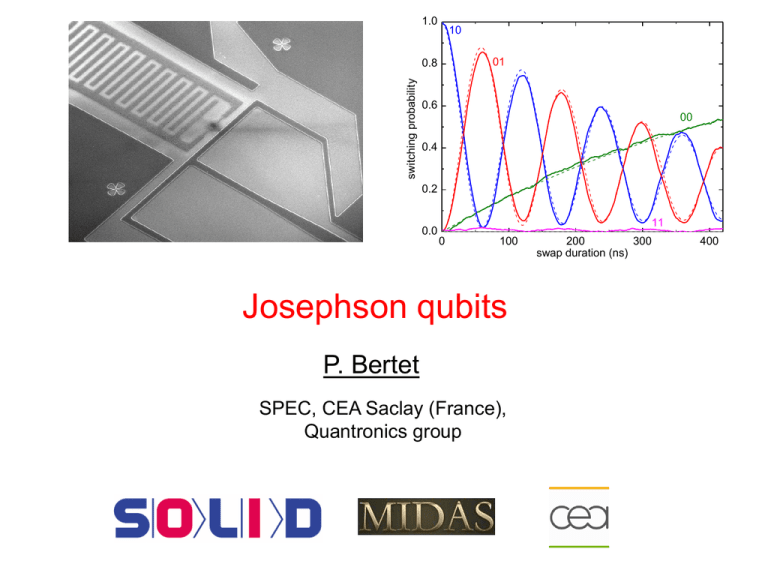
1.0 10 01 switching probability 0.8 0.6 00 0.4 0.2 0.0 11 0 100 Josephson qubits P. Bertet SPEC, CEA Saclay (France), Quantronics group 200 300 swap duration (ns) 400 Outline Lecture 1: Basics of superconducting qubits Lecture 2: Qubit readout and circuit quantum electrodynamics 1) Readout by a linear resonator 2) Nonlinear resonators for high-fidelity readout 3) Resonant qubit-resonator coupling: quantum state engineering and tomography Lecture 3: 2-qubit gates and quantum processor architectures Fabrication techniques small junctions 1) e-beam patterning 2) development 3) first evaporation 4) oxidation 5) second evap. 6) lift-off 7) electrical test e-beam lithography e- Al/Al2O3/Al junctions O2 PMMA PMMA-MAA SiO2 I.3) Decoherence small junctions Multi angle shadow evaporation QUANTRONIUM (Saclay group) gate I.3) Decoherence 160 x160 nm FLUX-QUBIT (Delft group) I.3) Decoherence TRANSMON QUBIT (Saclay group) 40mm 2mm I.3) Decoherence The ideal qubit readout relax. 1 a|0>+b|1> 1 0 a + b 0 0 ? 1 a + b 0 ? 1 a + b 0 ? 1 1111100 tmeas << T1 1 0 Hi-Fi 0000000 Quantum Non Demolishing (QND) BUT ….HOW ??? SURPRISING DIFFICULT AND INTERESTING QUESTION FOR SUPERCONDUCTING QUBITS II.1) Linear resonator The readout problem 1) Readout should be FAST : t meas T1 Ideally, t meas 1m s for high fidelity ( F 1 t meas / T1 ) 10ns 2) Readout should be NON-INVASIVE Unwanted transition caused by readout process (but full dephasing can’t be avoided !!!) errors 3) Readout should be COMPLETELY OFF during quantum state preparation (avoid backaction) II.1) Linear resonator Readout by a linear resonator 1D CPW resonator Superconducting artificial atom R. Schoelkopf, 2004 A. Blais et al., Phys. Rev. A 69, 062320 (2004) A. Walraff et al., Nature 431, 162 (2004) I. Chiorescu et al., Nature 431, 159 (2004) Modern readout methods by coupling to a resonator (CIRCUIT QUANTUM ELECTRODYNAMICS) II.1) Linear resonator Physical realization L=3.2cm, fn=n 1.8GHz 3mm 50mm Coupling capacitor Cc 10mm 20mm Typical lateral dimensions : 10mm - 1-dimensional mode - Very confined : Vcav 10 5 3 - Large voltage quantum fluctuations V0 II.1) Linear resonator mV - Quality factor easily tuned by designing Cc CPB coupled to a CPW resonator A. Blais et al., PRA 69, 062320 (2004) Vˆg V0 aˆ aˆ Vgext Cg c Vext ˆ nˆ 2 ˆ ˆ ˆ ˆ Htot EJ cos 4EC n ng c aˆ aˆ 2 ˆ ˆ Htot EJ cos 4EC nˆ ngext c aˆ aˆ 8(CgV0EC / 2e)nˆ(a a ) Hˆ q Hˆ cav Hˆ int 2-level approximation + Rotating Wave Approximation Htot II.1) Linear resonator ge 2 z c (a a 1/ 2) g ( a a ) Jaynes-Cummings Hamiltonian g 2eV0 (Cg / C ) 0 nˆ 1 Strong coupling regime with superconducting qubits g 2eV0 (Cg / C ) 0 nˆ 1 GEOMETRICAL dependence of g Easily tuned by circuit design Can be made very large ! (Typically : 0 – 200MHz) g 200MHz , 100 500kHz Strong coupling condition naturally fulfilled with superconducting circuits (Q=100 enough for strong coupling !!) II.1) Linear resonator The Jaynes-Cummings model d |g,3> d |e,3> HJ C |e,2> |g,2> |e,1> |g,1> |e,0> H J C ge 2 z c (a a 1/ 2) g ( a a ) couples only level doublets |g,n+1> , |e,n> Exact diagonalization possible |g,0> Restriction of HJ-C to g, n 1 g, n 1 e, n |g,n+1> , |e,n> e, n (n 1)c / 2 g n 1 g n 1 ( n 1) / 2 c Note : |g,0> state is left unchanged by HJ-C with Eg,0=-/2 II.1) Linear resonator ge c The Jaynes-Cummings model d |g,3> d |e,3> |e,2> |g,2> |e,1> |g,1> |e,0> HJ C H J C ge 2 z c (a a 1/ 2) g ( a a ) couples only level doublets |g,n+1> , |e,n> Exact diagonalization possible |g,0> Coupled states , n cosn e, n sinn g, n 1 E,n (n 1) c , n sinn e, n cosn g, n 1 E,n (n 1) c n II.1) Linear resonator 2g n 1 1 tan1 2 2 2 4g 2 (n 1) 2 4g 2 (n 1) 2 The Jaynes-Cummings model 1.08 e, n E/(hc) 1.04 g, n 1 g, n 1 1.00 0.96 e, n 0.92 -5 0 /g II.1) Linear resonator 5 The Jaynes-Cummings model 1.08 ,n e, n E/(hc) 1.04 g, n 1 1.00 g, n 1 2g n 1 ,n 0.96 e, n 0.92 -5 0 /g II.1) Linear resonator 5 Two interesting limits 1.08 ,n e, n E/(hc) 1.04 g, n 1 1.00 g, n 1 2g n 1 ,n 0.96 RESONANT REGIME (=0) e, n 0.92 -5 0 /g II.1) Linear resonator 5 Two interesting limits 1.08 ,n e, n E/(hc) 1.04 g, n 1 1.00 g, n 1 2g n 1 ,n 0.96 RESONANT REGIME (=0) e, n 0.92 -5 DISPERSIVE REGIME (||>>g) II.1) Linear resonator 0 /g 5 DISPERSIVE REGIME (||>>g) Two interesting limits 1.08 ,n e, n E/(hc) 1.04 g, n 1 QUANTUM STATE ENGINEERING 1.00 2g n 1 g, n 1 ,n 0.96 QUBIT STATE e,READOUT n RESONANT REGIME (=0) QUBIT STATE READOUT 0.92 -5 DISPERSIVE REGIME (||>>g) II.1) Linear resonator 0 /g 5 DISPERSIVE REGIME (||>>g) The Jaynes-Cummings model : dispersive interaction g HJ C / ge 2 z (c z )aa with g2 ge 2 (aa 1/ 2) 2 z c a a the dispersive coupling constant 1) Qubit state-dependent shift of the cavity frequency c c z Cavity can probe the qubit state non-destructively 2) Light shift of the qubit transition in the presence of n photons ge 2 n Field in the resonator causes qubit frequency shift and decoherence II.1) Linear resonator Dispersive readout of a transmon: principle ωc + χσ z |0> or |1> ?? II.1) Linear resonator Dispersive readout of a transmon: principle Veiωc t Veiωc t ωc + χσ z |0> or |1> ?? =c II.1) Linear resonator Dispersive readout of a transmon: principle Veiωc t Veiωc t ωc + χσ z |a1 |a0 =c II.1) Linear resonator |0> or |1> ?? Dispersive readout of a transmon: principle Veiωc t Veiωc t iωc t + Ve ωc + χσ z |a1 |a0 =c p 2 |0> p |1> 0,96 II.1) Linear resonator 1,00 d/c 1,04 |0> or |1> ?? Dispersive readout of a transmon: principle Veiωc t Veiωc t iωc t + Ve ωc + χσ z |a1 |a0 L.O =c 0 p or 1 ??? 2 |0> p |1> 0,96 II.1) Linear resonator 1,00 d/c 1,04 |0> or |1> ?? Typical implementation (Saclay) 5 mm (f0=6.5GHz) Q=700 80mm g 45MHz 40mm II.1) Linear resonator 2mm (optical+e-beam lithography) Typical setup (Saclay) MW meas I MW drive COIL Vc 20dB 50MHz LO dB 20dB Fast Digitizer Q G=56dB A(t) (t) 300K G=40dB TN=2.5K 50 4K DC-8 GHz 30dB 600mK 1.4-20 GHz 20dB II.1) Linear resonator 4-8 GHz 50 18mK Observation of the vacuum Rabi splitting with electrical circuits (courtesy of S. Girvin) Signature for strong coupling: Placing a single resonant atom inside the cavity leads to splitting of transmission peak 2008 vacuum Rabi splitting atom off-resonance observed in: cavity QED R.J. Thompson et al., PRL 68, 1132 (1992) I. Schuster et al. Nature Physics 4, 382-385 (2008) on resonance circuit QED A. Wallraff et al., Nature 431, 162 (2004) quantum dot systems J.P. Reithmaier et al., Nature 432, 197 (2004) T. Yoshie et al., Nature 432, 200 (2004) II.1) Linear resonator 28 A. Wallraff et al., Nature 431, 162 (2004) Qubit spectroscopy with dispersive readout -120 MW drv g Pump TLS Probe resonator phase MW meas (°) -122 -124 -126 Some e 5,25 p 5,30 Drive freq (GHz) e g p 0.95 1.00 /c II.1) Linear resonator 1.05 5,35 Typical spectroscopy of a transmon + cavity circuit 6.5 01 frequency (GHz) 12 6.0 c 5.5 5.0 0.0 II.1) Linear resonator 0.5 /2p 1.0 1.5 Rabi oscillations measured with dispersive readout Δt MW drv Variable-length drive MW meas Projective measurement x 10000 Ensemble averaging -108 0 -111 X (°) Y T2R=316 ns -114 1 -117 0 II.1) Linear resonator 200 400 600 t (ns) 800 1000 Dispersive readout : the signal-to-noise issue Veiωc t Veiωc t iωc t + Ve ωc + χσ z |a1 |a0 Ideal amplifier L.O =c 0 p or 1 ??? 2 |0> p |1> 0,96 II.1) Linear resonator 1,00 d/c 1,04 |0> or |1> ?? Dispersive readout : the signal-to-noise issue Veiωc t Veiωc t iωc t + Ve Real amplifier TN=5K ωc + χσ z 0 p or 1 ??? 2 |1> 0,96 II.1) Linear resonator No discrimination in 1 shot |0> p |0> or |1> ?? |a0 L.O =c |a1 1,00 d/c 1,04 Dispersive readout : the signal-to-noise issue Veiωc t Veiωc t QUANTUMLIMITED AMPLIFIER ?? iωc t + Ve ωc + χσ z |a1 |a0 Real amplifier TN=5K L.O =c 0 p or 1 in one single-shot ?? 2 |0> p |1> 0,96 II.1) Linear resonator |0> or |1> ?? 1,00 d/c 1,04 How to build an amplifier with minimal noise ??? pump signal in signal out Nonlinear resonator /4 /4 Junction causes Kerr non-linearity K + 2 2 Hc = ωc a a + (a ) a 2 + Resonator can behave as parametric amplifier K. Lehnert group M. Devoret group I. Siddiqi group II.2) Nonlinear resonator A nonlinear resonator as quantum-limited amplifier max II.2) Nonlinear resonator M. J. Hatridge, R. Vijay, D. H. Slichter, J. Clarke and I. Siddiqi, Phys. Rev. B 83, 134501 (2011) (courtesy I. Siddiqi) A nonlinear resonator as quantum-limited amplifier Small Saturated signal II.2) Nonlinear resonator (courtesy I. Siddiqi) Signal-to-noise enhancement by a paramp M. Castellanos-Beltran, K. Lehnert, APL (2007) (quantum limit on how good an amplifier can be : Caves theorem) Actually reached in several experiments : quantum limited measurement II.2) Nonlinear resonator Qubit and amplifier at 30 mK OUTPUT INPUT DRIVE II.2) Nonlinear resonator (courtesy I. Siddiqi) Individual measurement traces readout off readout on R. Vijay, D.H. Slichter, and I. Siddiqi, PRL 106, 110502 (2011) II.2) Nonlinear resonator (courtesy I. Siddiqi) Bivalued histograms Single-shot discrimination of qubit state II.2) Nonlinear resonator (courtesy I. Siddiqi) Other strategy : sample-and-hold detector integrated with qubit pump /4 /4 Nonlinear resonator used as threshold detector II.2) Nonlinear resonator Other strategy : sample-and-hold detector integrated with qubit Kerr-nonlinear resonator /4 /4 pump H Pd /Pc = 0.2 0.5 1.0 1.8 I Ic 0.2 L 0.1 0 II.2) Nonlinear resonator 2 0 -2 BISTABILITY FOR c 3 The Cavity Josephson Bifurcation Amplifier (CJBA) M. Devoret group, Yale MW drive : Pd(t) , d in JBA: I. Siddiqi et al., PRL (2004) CJBA: M. Metcalfe et al, PRB (2007) Non linear resonator out H Pd Pd H state Bistable region L Switching from L to H : BIFURCATION d L state c II.2) Nonlinear resonator Stochastic process governed by thermal or quantum noise. M.I. Dykman and M.A. Krivoglaz, JETP 77, 60 (1979) M.I. Dykman and V.N. Smelyanskiy, JETP 67, 1769 (1988) The Cavity Josephson Bifurcation Amplifier (CJBA) M. Devoret group, Yale MW drive : Pd(t) , d in JBA: I. Siddiqi et al., PRL (2004) CJBA: M. Metcalfe et al, PRB (2007) Non linear resonator out H Pd Pd H state Bistable region d L state c Switching probability L 1,0 0,8 0,6 0,4 0,2 0,0 -36 -35 -34 Power Pd (dB) II.2) Nonlinear resonator -33 Readout of transmon with CJBA MW drive : Pd(t) , d in Non linear resonator out qubit in |0> or Pd H state L state 2 c|1> c|0> d Switching Porbability Pd |1> 1,0 0,8 |1> 0,6 0,4 0,2 0,0 |0> -38 -37 -36 -35 -34 -33 SINGLE-SHOT QUBIT READOUT II.2) Nonlinear resonator Power Pd (dB) Rabi oscillations visibility 2 h12 1 h01 0 t tp,12 250ns 400ns 1,0 Pswitch (%) 0,8 0,6 0,4 0,2 TRabi=500ns 0,0 -38 -36 -34 0,0 0,2 0,4 0,6 t (µs) 0,8 Mallet et al., Nature Physics (2009) Single-shot 93% contrast Rabi oscillations II.2) Nonlinear resonator See also A. Lupascu et al., Nature Phys. (2007)


